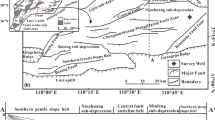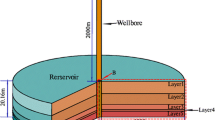Abstract
A simplified two-dimensional axisymmetric model was established based on a typical continental sedimentary basin in China to simulate the thermal evolution of wellbore and reservoir during the injection of CO2 by taking consideration of lithology heterogeneity of reservoir. By comparing with two simple one-dimensional theory models, the lithology heterogeneity influence on CO2 mass flow rate distribution along depth in the wellbore is identified. Results suggested that the interaction of multiple layers in the heterogeneous reservoir will influence the CO2 mass flow rate distribution along depth in the wellbore so as to impact the corresponding temperature and pressure evolution in the wellbore and reservoir. Layer burial depth (or relative location), porosity, permeability and thickness are all important factors that affect CO2 mass flow rate in wellbore. The variation of CO2 mass flow rate in the wellbore will change the CO2 temperature flowing into each layers through impact the heat extraction from rocks, compressibility of CO2 and potential energy loss, and by varying the CO2 hydrostatic pressure and pressure drop due to friction to determine the CO2 injection pressure. Layer burial depth, porosity, permeability and thickness are all important factors that affect the CO2 mass flow rate distribution in the wellbore. This study may help deepen our understanding of CO2 flow and thermal evolution in the actual heterogeneous reservoir and provide important knowledge supplement for the liquid injection (especially CO2) into underground, such as deep saline aquifer, depleted oil/gas reservoir and coal bed.















Similar content being viewed by others
References
Altunin VV (1975) Thermophysical properties of carbon dioxide. Publishing House of Standards. Moscow, pp 551. (in Russian)
André L, Azaroual M, Menjoz A (2010) Numerical simulations of the thermal impact of supercritical CO2 injection on chemical reactivity in a carbonate saline reservoir. Transp Porous Med 82(1):247–274
Ascencio F, Samaniego F, Rivera J (2014) A heat loss analytical model for the thermal front displacement in naturally fractured reservoirs. Geothermics 50:112–121
Bai B, Li XC, Liu MZ, Shi L, Li Q (2012) A fast explicit finite difference method for determination of wellhead injection pressure. J Central South Univ Technol 19:3266–3272
Barends F (2010) Complete solution for transient heat transport in porous media, following Lauwerier. SPE. doi:10.2118/134670-MS
Bielinski A, Kopp A, Schütt H (2008) Monitoring of CO2 plumes during storage in geological formations using temperature signals: numerical investigation. Int J Greenh Gas Con 2(3):319–328
Bodvarsson G (1972) Thermal problems in the siting of reinjection wells. Geothermics 1(2):63–66
Chen C, Reddell DL (1983) Temperature distribution around a well during thermal injection and a graphical technique for evaluating aquifer thermal properties. Water Resour Res 19(2):351–363
Dickinson JS, Buik N, Matthews MC, Snijders A (2009) Aquifer thermal energy storage: theoretical and operational analysis. Geotechnique 59(3):249–260
Duan Z, Sun R (2003) An improved model calculating CO2 solubility in pure water and aqueous NaCl solutions from 273 to 533 K and from 0 to 2000 bar. Chem Geol 193(3):257–271
Han Z, Fang Q, Song B, Lu W, Wang Z, Xu B, Gao H (2008) Characteristics of gas reservoir in the palaeozoic Shan_2 ~ 3 of Zizhou-Qingjing Area, Ordos Basin. J Northwest Univ 3:030 (in Chinese)
Han WS, Stillman GA, Lu M, Lu C, McPherson BJ (2010) Evaluation of potential non-isothermal processes and heat transport during CO2– sequestration. J Geophys Res 115(B7). doi:10.1029/2009JB006745
Han WS, Kim K, Park E, McPherson BJ, Lee S, Park M (2012) Modeling of spatiotemporal thermal response to CO2 injection in saline formations: interpretation for monitoring. Transp Porous Med 93(3):381–399
Hasan AR, Kabir CS (1994) Aspects of wellbore heat transfer during two-phase flow (includes associated papers 30226 and 30970). SPE Prod Facil 9(03):211–216
International Formulation Committee (1967) A formulation of the thermodynamic properties of ordinary water substance. IFC Secretariat, Dusseldorf
Jiang P, Li X, Xu R, Wang Y, Chen M, Wang H, Ruan B (2014) Thermal modeling of CO2 in the injection well and reservoir at the Ordos CCS demonstration project, China. Int J Greenh Gas Control 23:135–146
Kocabas I (2004) Thermal transients during non-isothermal fluid injection into oil reservoirs. J Petrol Sci Eng 42(2–4):133–144
Kocabas I, Islam MR (2000) Concentration and temperature transients in heterogeneous porous media. J Petrol Sci Eng 26(1):221–233
Koschel D, Coxam J, Rodier L, Majer V (2006) Enthalpy and solubility data of CO2 in water and NaCl(aq) at conditions of interest for geological sequestration. Fluid Phase Equilib 247(1):107–120
Lauwerier HA (1965) The transport of heat in an oil layer caused by the injection of hot fluid. Appl Sci Res A 5:145–150
Li K, Nassori H, Horne RN (2010) Experimental study of water injection into geothermal systems. Transp Porous Med 85(2):593–604
Liu H, Hou Z, Were P, Gou Y, Sun X (2014) Simulation of CO2 plume movement in multilayered saline formations through multilayer injection technology in the Ordos Basin China. Environ Earth Sci 71(10):4447–4462
Liu D, Li Y, Xu L, Yu Y (2015) Numerical investigation of the influence of interaction between wellbore flow and lateral reservoir flow on CO2 geological sequestration. Environ Earth Sci 74(1):715–726
Mathias SA, Gluyas JG, Oldenburg CM, Tsang CF (2010) Analytical solution for Joule-Thomson cooling during CO2 geo-sequestration in depleted oil and gas reservoirs. Int J Greenh Gas Con 4(5):806–810
Mireault R, Stocker R, Dunn D, Pooladi-Darvish M (2010) Wellbore dynamics of acid gas injection well operation. SPE. doi:10.2118/135455-MS
Oldenburg CM (2007) Joule-Thomson cooling due to CO2 injection into natural gas reservoirs. Energ Convers Manage 48(6):1808–1815
Pan L, Oldenburg CM (2014) T2Well—an integrated wellbore–reservoir simulator. Comput Geosci UK 65:46–55
Paterson L, Ennis-King J, Sharma S (2010) Observations of thermal and pressure transients in carbon dioxide wells. SPE. doi:10.2118/134881-MS
Ruan B, Xu R, Wei L, Ouyang X, Luo F, Jiang P (2013) Flow and thermal modeling of CO2 in injection well during geological sequestration. Int J Greenh Gas Control 19:271–280
Sagar R, Doty DR, Schmidt Z (1991) Predicting temperature profiles in a flowing well. SPE Prod Eng 6(4):441–448
Satman A (1988) Solutions of heat, and fluid-flow problems in naturally fractured reservoirs: part 1-heat-flow problems. SPE Prod Eng 3(4):463–466
Spycher N, Pruess K (2010) A phase-partitioning model for CO2—brine mixtures at elevated temperatures and pressures: application to CO2 enhanced geothermal systems. Transp Porous Med 82(1):173–196
Van Genuchten MT (1980) A closed-form equation for predicting the hydraulic conductivity of unsaturated soils. Soil Sci Soc Am J 44(5):892–898
Yortsos Y, Gavalas G (1982) Heat transfer ahead of moving condensation fronts in thermal oil recovery processes. Int J Heat Mass Tran 25(3):305–316
Zhao R, Cheng J (2014). Non-isothermal modeling of CO2 injection into saline aquifers at a low temperature. Environ Earth Sci 73(9):5307–5316
Acknowledgments
The support from the Research Fund for the Doctoral Program of Higher Education (No. 20120145110005) is acknowledged. Also, this work was also partially supported by the National Natural Science Foundation of China (NSFC, No. 41572233) and the special Scientific Research Fund of Public Welfare Profession of the Ministry of Land and Resources of China (No. 201211063-3-2).
Author information
Authors and Affiliations
Corresponding author
Rights and permissions
About this article
Cite this article
Liu, D., Li, Y., Song, S. et al. Simulation and analysis of lithology heterogeneity on CO2 geological sequestration in deep saline aquifer: a case study of the Ordos Basin. Environ Earth Sci 75, 962 (2016). https://doi.org/10.1007/s12665-016-5754-7
Received:
Accepted:
Published:
DOI: https://doi.org/10.1007/s12665-016-5754-7




